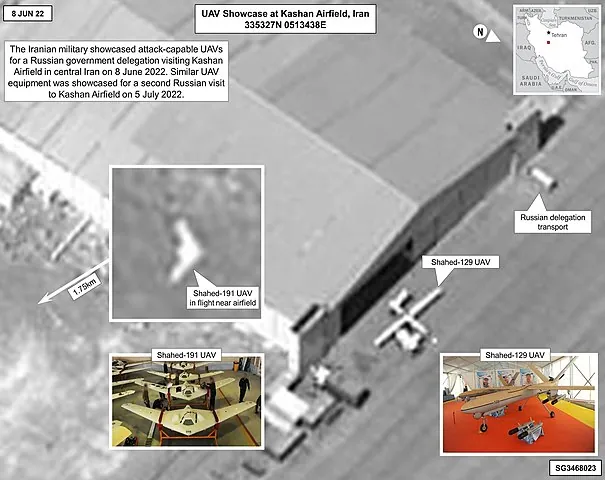Unmanned aerial vehicles (UAVs), commonly known as drones, have revolutionized the military and civilian sectors with their ability to perform various tasks autonomously. Among the innovative drones that have emerged in recent years, the Shahed-191 drone, developed by Iran, has garnered significant attention due to its advanced capabilities and strategic significance. This article explores the key features, applications, and impact of the Shahed-191 drone on the Iranian defense industry and regional dynamics.
Advanced Capabilities of Shahed-191 Drone
The Shahed-191 drone, designed and manufactured by Iran’s Shahed Aviation Industries, boasts an array of advanced capabilities that enhance its operational efficiency and effectiveness.
The Shahed-191 is a variant of the Iranian turbofan/piston-powered flying wing unmanned combat aerial vehicle Shahed Saegheh. The word Saegheh means thunderbolt. The Saegheh drone is a smaller and distinct version inspired by the Lockheed Martin RQ-170 Sentinel UAV. It was reverse-engineered by Iran after the country captured an RQ-170 Sentinel in 2011.
Key features of the Shahed-191 drone
- Features frontal air intakes, except for piston engine models.
- Takes off from specialized racks mounted on speeding vehicles, potentially Toyota Hilux trucks.
- Equipped with retractable landing skids for runway recovery.
- Approximately 60% of the size of the RQ-170 Sentinel.
- Carries two Sadid-1 missiles internally.
- Cruising speed of 300 km/h.
- Endurance of 4.5 hours.
- Range of 450 km.
- Payload capacity of 50 kg.
- Ceiling altitude of 25,000 ft.
- Wing span of 7.31 meters.
- Length of 2.7 meters.
- Maximum takeoff weight of 500 kg.
- Maximum speed of 350 km/h
- Uses a micro turbojet engine
Operational history
The Shahed-191 drone has been extensively utilized by Iran in various applications across the Middle East. These applications include both offensive operations and intelligence gathering targeting the United States and Israel.
In February 2018, thus, Israel intercepted and shot down a Shahed-191 drone that had entered its airspace from Syria. This incident highlighted the capability of the drone to breach international borders and carry out surveillance or potentially more aggressive actions.
Furthermore, the Islamic Revolutionary Guard Corps (IRGC) deployed the Shahed-191 in a combined drone and missile attack against the Islamic State in Syria in October 2018. This operation showcased the drone’s ability to conduct offensive strikes and demonstrated its role in Iran’s regional military activities.
Regional Dynamics and Global Implications
The Shahed-191 drone has implications not only for Iran but also for regional dynamics and global security considerations. The increased deployment of UAVs by Iran, coupled with the potential transfer of this technology to state and non-state actors, could potentially reshape the balance of power in the region.
In June 2022, satellite imagery released by the White House revealed that a Russian delegation had visited an airfield in central Iran to view Iranian drones, including the Shahed-191 and Shahed-129 models.
Consequently, in February 2023, the Guardian reported that Iran smuggled several long-ranged armed drones, including 6 Mohajer-6 drones and 12 Shahed-191 and Shahed-129 drones following the visit.
Summary of ‘Shahed-191 Drone’
In conclusion, the Shahed-191 drone represents a significant milestone in Iran’s pursuit of advanced unmanned aerial technology. With its impressive range, endurance, and advanced imaging systems, the drone has demonstrated its effectiveness in military applications. Its capabilities have strengthened Iran’s drone industry and showcased the country’s ability to develop sophisticated drones indigenously. The Shahed-191’s impact extends beyond national boundaries, influencing regional dynamics and prompting other nations to reassess their defense strategies.
FAQs
Q1: What is the Shahed-191 drone?
A1: The Shahed-191 drone is an unmanned aerial vehicle (UAV) developed by Iran. It is based on the captured Lockheed Martin RQ-170 Sentinel UAV, but it is smaller and substantially different in design.
Q2: How does the Shahed-191 drone take off and land?
A2: The Shahed-191 drone takes off from specialized racks mounted on vehicles, potentially Toyota Hilux trucks, that speed down a runway. It is then recovered on a runway using retractable landing skids.
Q3: What are the key features and specifications of the Shahed-191 drone?
A3: The Shahed-191 drone has a cruising speed of 300 km/h and an endurance of 4.5 hours. Moreover, it has a range of 450 km and a payload capacity of 50 kg. The drone has a ceiling altitude of 25,000 ft and a wing span of 7.31 meters. Additionally, Its length is 2.7 meters, and it has a maximum takeoff weight of 500 kg. The maximum speed of the drone is 350 km/h.
Q4: What armament does the Shahed-191 drone carry?
A4: The Shahed-191 drone carries two Sadid-1 missiles internally, providing it with offensive capabilities.
Q6: What is the size comparison between the Shahed-191 and the RQ-170 Sentinel?
A6: The Shahed-191 drone is approximately 60% of the size of the Lockheed Martin RQ-170 Sentinel UAV that it is based on, indicating a smaller and more compact design.
Q8: Are there any export potentials for the Shahed-191 drone?
A8: As an indigenous drone with advanced capabilities, the Shahed-191 has the potential for export to interested nations seeking unmanned aerial technology. Meanwhile, according to a Guardian report, Iran exported a dozen of Shahed-191 drones to Russia.









